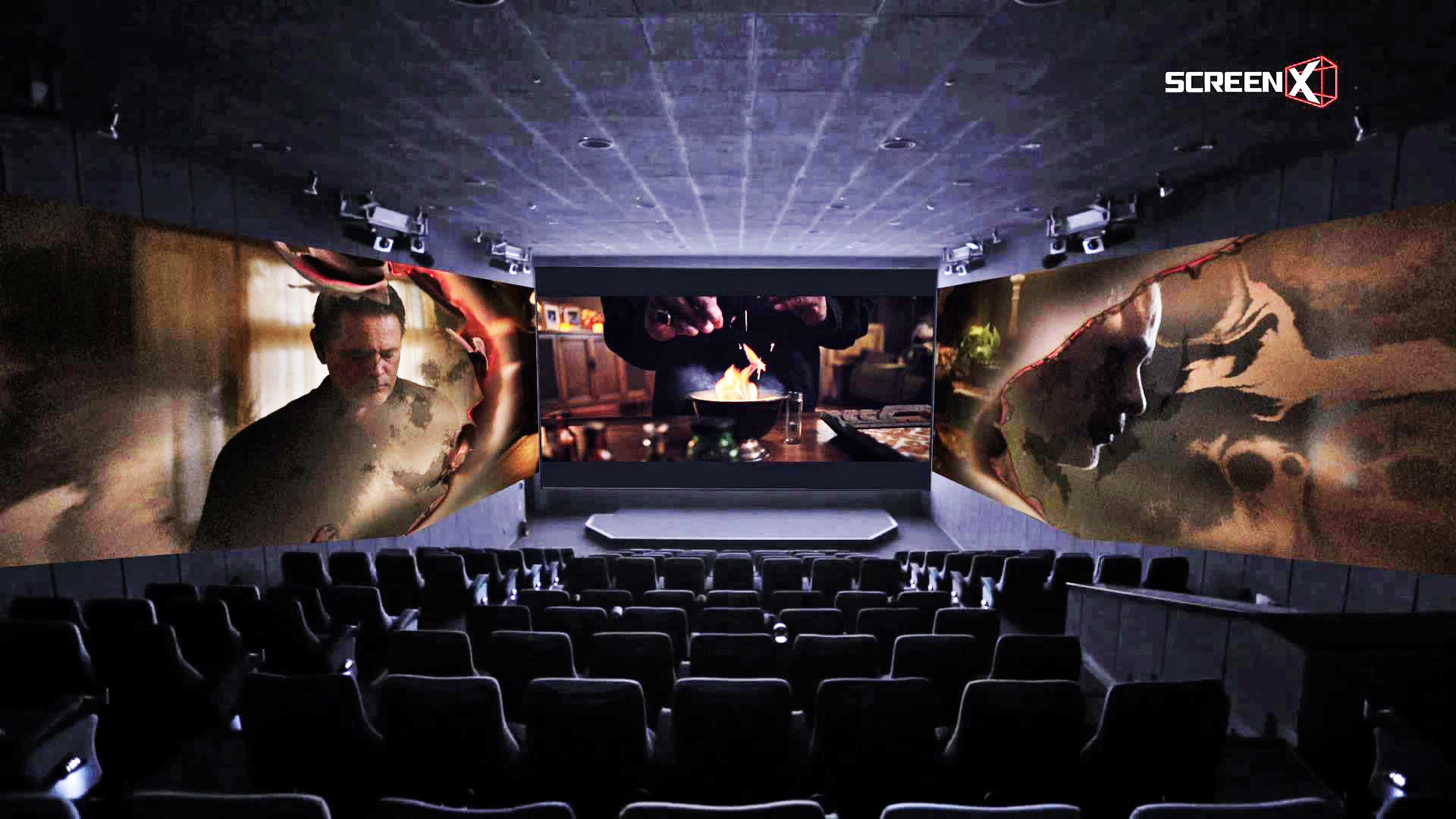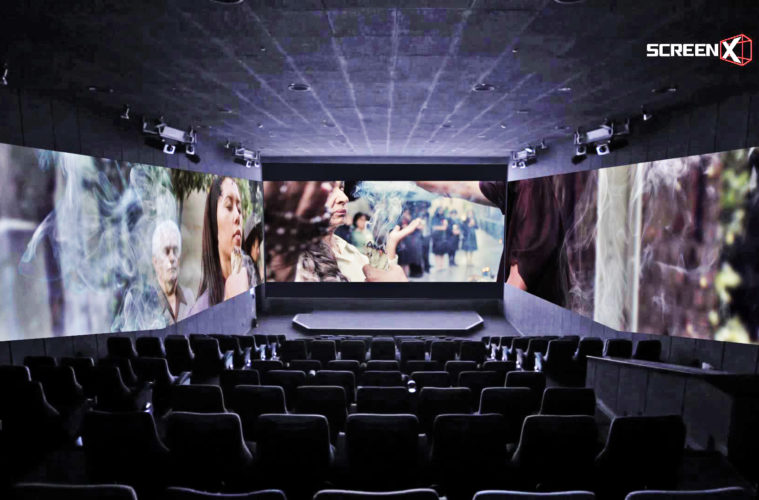When you’re going to the movies, your choices begin long before you reach the cinema: Do you want to reserve your seat in advance? Which online service do you use to make your reservation? Which row would you like to sit in? Would you like extra carry-on luggage? Oh wait! Wrong industry. You get the idea, though.
From combination snack choices at the concession area to theatrical membership services, there is no shortage of options to custom-tailor one’s movie-going experience. As far as the actual theater is concerned, exhibitors have been toying with techniques to make movies into more of an immersive experience for nearly a hundred years, since the first 3D film The Power of Love was released, worldwide, in 1922.

Photo courtesy of CJ 4DPLEX
Starting in the late 1950s, actor/writer/producer/director William Castle introduced a bevy of gimmicks into theaters in order to promote his horror films, and, in 1960, Hans Laube’s Smell-O-Vision, which filled theaters with various odors intended to complement the film, was a disaster that was used only once. While the 3D fad has come and gone a few times, large screens (predominantly IMAX and XD), enhanced audio, stadium seating and comfy chairs are currently the basic go-to luxury options of the cinematic experience (though 4DX — which includes motion-enabled chairs and theaters equipped to simulate lightning, rain, fog and scents — is on the rise).
The latest to join this trend in Irvine is ScreenX. This reporter was recently invited to attend a presentation of the film The Curse of La Llorona at Edward’s Irvine Spectrum 21’s ScreenX-equipped theater. In addition to attending the screening, Irvine Weekly also had the opportunity to ask Paul Kim, VP of Studio Relations and ScreenX Production, a bit about the ScreenX technology and its increasing popularity among theaters throughout the world.
While attending the screening of The Curse of La Llorona, the first evidence of the ScreenX technology occurred after the previews. Two additional projectors, which were mounted on the ceiling, projected onto two additional screens. That is, the walls on either side of the screen became additional screens; the images were synchronized so that the effect for viewers was basically one of being surrounded by a singular, expansive, wrap-around image. The content that was projected was the ScreenX company logo sequence — an animated bit of fun that made terrific use of the technology, which is reminiscent of the enveloping experience of VR technology. I was sold. Then the movie began, and I experienced the disconnect between the potential of ScreenX and the current state of it as demonstrated by La Llorona.

Photo courtesy of CJ 4DPLEX
The essential problem was that the film was not shot in a manner befitting (no pun intended) the wraparound screen. The secondary screens were used in a variety of ways throughout the film, but, for most of the film, they were not used at all. The alternating appearance and disappearance of peripheral imagery removed me from the experience of the film’s narrative and kept me aware that a gimmick was at play. In this instance, the film itself was a mediocre exercise in horror entertainment; therefore, being removed from the story so that I could study / experience the ScreenX properties was not that big a deal. However, when the effect was active, it was not used in a uniform manner. Specifically, the peripheral sides were used in different ways at different times.
Sometimes they were used to flash incidental or jarring images that were not part of the image composition on the main screen — as in the momentary appearance of a screaming face or an atmospheric field of smoke. More frequently, they were used to expand the central image for a tracking shot, like when the camera moved in on a lone character in the center of a field (or something to that effect). The principal problem with that was it did not seem as though the peripheral aspects had been shot in tandem with the central image. Sometimes, the movement on the various screens did not synchronize properly, and sometimes, for example, it seemed as though the forest trees on one screen were not the same as the forest trees on another. This made me wonder if the peripheral imagery had even been shot when the rest of the movie was shot or if they were manufactured after-the-fact for the ScreenX presentation.
Screen X’s Paul Kim confirmed my observation and pointed out that although no Hollywood features have yet been shot for ScreenX (all ScreenX effects are shot / generated in post-production), projects are already being shot that way abroad.
He said, “For our other films from Korea [and] China, we HAVE shot in the ScreenX format as we have specific cameras and rigs available for ScreenX production.” He provided examples: “We shot the BTS World Tour: Love Yourself in Seoul performance at Olympic Stadium live and [were] able to put together an incredible viewing experience for those who weren’t able to attend or for those who wanted to relive the experience. We also got in [during] the pre-production stage with the South Korean horror hit Gonjiam last year. It is a terrifying film that we were able to make even scarier. Imagine long corridors that stretch onto the walls of the theater, putting you smack dab in the middle of the action, or things flickering in your peripherals while dread and suspense fill the main screen.”
In regard to theaters that have been or will be selected for ScreenX presentations, Kim pointed out that the modifications required for exhibition include adding ScreenX servers for communication between the projectors, retrofitting the theater walls with special fabric panels for optimal visibility, and, of course, adding the additional projectors. The theaters selected for the modifications must also meet certain requirements, such as location / marketability, theater length, central screen size (must be wall to wall with no gaps between screen and room corners), and there must be no columns, sconces or other obstructions.
Given these parameters, Kim pointed out that last year ScreenX has expanded from 142 screens to 208, around the world. The Cineworld Group (which owns Regal Cinemas, including Regal, Edwards, and United Artists Theatres, as well as several other subsidiaries around the globe) has been ScreenX’s biggest champion — bringing ScreenX to 100 theaters across the U.S. and U.K. With additional new exhibitor contracts in Nigeria, India, Mexico and Belarus, Kim has shown that ScreenX continues to expand operations rapidly. I, for one, look forward to witnessing the growth of this new facet of theatrical immersion, both in terms of its use by more filmmakers and in terms of its proliferation throughout the ever-evolving cinema industry.
Advertising disclosure: We may receive compensation for some of the links in our stories. Thank you for supporting Irvine Weekly and our advertisers.

